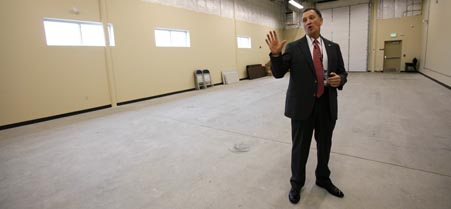Governments to rely on high-tech security center for Olympics
Employees from 70 federal, state and local agencies will use data streaming into the Olympic Security Coordination Center from roadside cameras, aircraft video and digital maps to provide security for the games.
 Mark Beaty, federal coordinator for the Olympic security center, says agencies can coordinate with Canadian security.
Mark Beaty, federal coordinator for the Olympic security center, says agencies can coordinate with Canadian security.
When the 2010 Winter Olympics opens in Vancouver, B.C., in February, teams from 70 federal, state and local agencies will oversee safety measures on the U.S. side of its border with Canada from a new high-tech Olympic Security Coordination Center.
The center, in Bellingham, Wash., 20 miles south of the border, is the focal point for ramped up security for the games, which run from Feb. 12-28. It is the most visible result of an intragovernmental security effort that began in 2005, said Washington State Patrol Capt. Greg Miller, lead planner for the U.S. 2010 Olympics Security Committee.
The 2010 Winter Olympics marks the first time a concentrated and coordinated effort of this magnitude has been applied to a major event outside the United States, said Mark Beaty, federal coordinator for the Olympics Security Committee for the Homeland Security Department.
Beaty, whose primary job is director of operations at the Office of Air and Marine in the Customs and Border Protection bureau in Washington, said the center has the ability to communicate and coordinate with Canadian security forces, including the Royal Canadian Mounted Police.
Staff will occupy the center 24 hours a day during the games, with federal, state and local personnel working 12-hour shifts in a multiagency system. The center will help coordinate response to problems on the border, ranging from traffic jams to major security incidents.
The center is equipped with nine work pods with 54 workstations, each of which has high-speed data and voice connections. The pods group personnel by specialty and agency, ranging from the Whatcom County Sheriff's Office in Bellingham to the FBI, all in the same room.
The center's focal points are 13 50-inch computer monitors and eight wide-screen projection systems that can display a range of information, including feeds from traffic cameras operated by the Washington State Transportation Department on roads leading to border crossings, and maps and overlays provided by the National Geospatial Intelligence Agency.
The screens also display airspace overlays from the Federal Aviation Administration, which has established airspace management zones for the Olympics, and feeds from cameras mounted in the nose of aircrafts piloted by the Customs and Border Protection.
The network supports voice communications for the U.S. Olympic security operations and stands as a hallmark of federal and state cooperation, said Robert Schwent, commander of the electronics system division of the Washington State Patrol.
The patrol operates a broadband microwave network and a combination of state and federal funding helped upgrade the network to relay voice radio traffic for government agencies that provide security for the Olympics. Washington state spent $3 million to expand the network's backbone and the federal government contributed $10 million through Public Safety Interoperability Grants.
The federal government also contributed $500,000 to expand the Justice Department's Integrated Wireless Network, which sits atop Sumas Mountain, a 3,340-foot peak 23 miles northeast of Bellingham, to improve coordination among federal, state and local agencies.
Despite the center's advanced communications and computers, Beaty said the greatest benefits come from having security personnel from multiple agencies in one room. "If I need an expert, all I need to do is walk over and talk to [one]," he said.
NEXT STORY: Strike Two?



